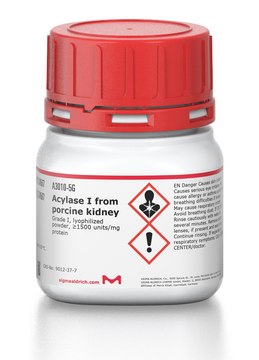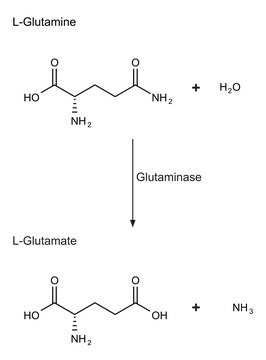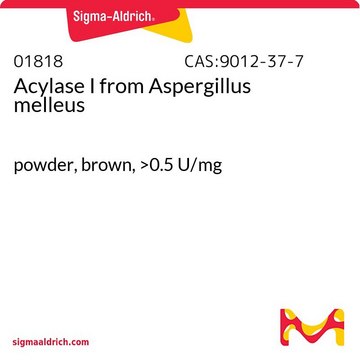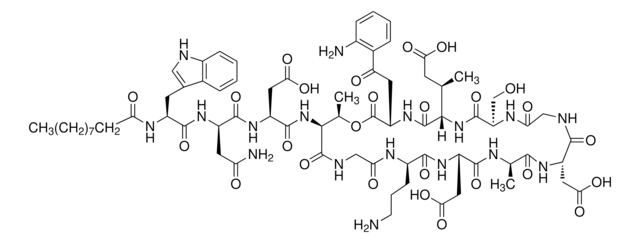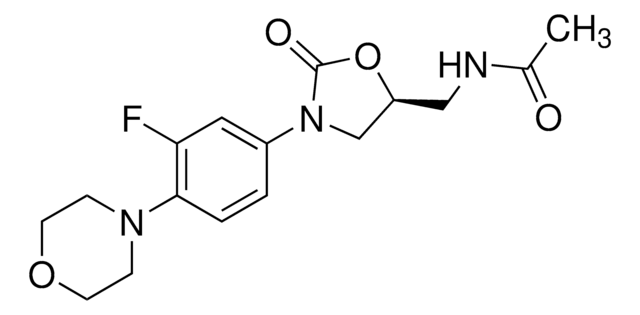A6691
Amidase from Pseudomonas aeruginosa
recombinant, expressed in E. coli, buffered aqueous glycerol solution, hydroxamate transferase ≥200 units/mg protein (biuret)
Synonym(s):
Acrylamide Amidohydrolase, Acylase
Sign Into View Organizational & Contract Pricing
All Photos(1)
About This Item
CAS Number:
MDL number:
UNSPSC Code:
12352204
NACRES:
NA.54
Recommended Products
recombinant
expressed in E. coli
Quality Level
form
buffered aqueous glycerol solution
hydroxamate transferase activity
≥200 units/mg protein (biuret)
concentration
14 mg/mL
UniProt accession no.
storage temp.
−20°C
Gene Information
Pseudomonas aeruginosa PAO1 ... PA4163(880181)
Looking for similar products? Visit Product Comparison Guide
Application
Amidase from Pseudomonas aeruginosa has been used for testing its capability to hydrolyze ochratoxin A.
The importance of these hydrolases in biotechnology is growing rapidly, because their potential applications span through chemical and pharmaceutical industries as well as in bioremediation. Immobilized amidase can be used efficiently for production of acrylic acid from acrylamide, thus converting a toxic ambient contaminant into widely used industrial raw material. Amidases are potential treatments for human immunodeficiency virus and malaria. They may be used to eliminate metal ions in wastewater .
Biochem/physiol Actions
The amidase from Pseudomonas aeruginosa isa 6 × 38-kDa enzyme that catalyzes the hydrolysis of a small range of short aliphatic amides. Each amidase monomer is formed by a globular four-layer αββα sandwich domain with an additional 81-residue long C-terminal segment .
Unit Definition
One unit will convert 1.0 μmole of acetamide and hydroxylamine to acetohydroxamate and ammonia per min at pH 7.2 at 37 °C.
Physical form
Solution in 50% glycerol containing 7 mM 2-mercaptoethanol and phosphate buffer salt
Signal Word
Danger
Hazard Statements
Precautionary Statements
Hazard Classifications
Resp. Sens. 1
Storage Class Code
12 - Non Combustible Liquids
WGK
WGK 1
Flash Point(F)
Not applicable
Flash Point(C)
Not applicable
Personal Protective Equipment
dust mask type N95 (US), Eyeshields, Gloves
Regulatory Information
常规特殊物品
Choose from one of the most recent versions:
Already Own This Product?
Find documentation for the products that you have recently purchased in the Document Library.
Jorge Andrade et al.
The Journal of biological chemistry, 282(27), 19598-19605 (2007-04-20)
Microbial amidases belong to the thiol nitrilases family and have potential biotechnological applications in chemical and pharmaceutical industries as well as in bioremediation. The amidase from Pseudomonas aeruginosa isa6 x 38-kDa enzyme that catalyzes the hydrolysis of a small range
Substrate interaction with recombinant amidase from Pseudomonas aeruginosa during biocatalysis
Pacheco R, Karmali A
Biocatalysis and Biotransformation, 27(5/6), 367-376 (2009)
Butyramide-utilizing mutants of Pseudomonas aeruginosa 8602 which produce an amidase with altered substrate specificity.
J E Brown et al.
Journal of general microbiology, 57(2), 273-285 (1969-08-01)
M Słowińska et al.
Theriogenology, 78(5), 1065-1077 (2012-06-19)
This study was designed to identify the effect of liquid storage at 4 °C for 48 h and cryopreservation on the proacrosin/acrosin system of turkey spermatozoa. Anti-acrosin I antibodies were produced and used to demonstrate Western blot analysis profile of
Vikash Babu et al.
Colloids and surfaces. B, Biointerfaces, 89, 277-282 (2011-09-29)
In this study, enzymatic surface modification of polyacrylonitrile was studied using nitrile metabolizing enzyme of Amycolatopsis sp. IITR 215. During enzymatic treatment of polyacrylonitrile at pH of 5.8 and 7, it was observed that the conversion of cyano group to
Our team of scientists has experience in all areas of research including Life Science, Material Science, Chemical Synthesis, Chromatography, Analytical and many others.
Contact Technical Service
